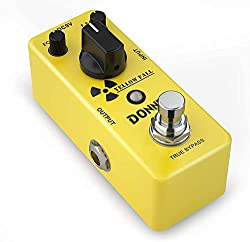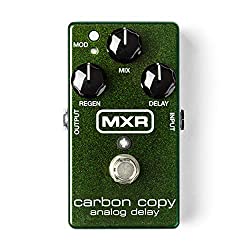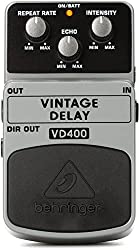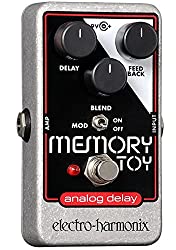When I learned about the warm sound effects analog delay pedals can produce, I knew I needed one to create vintage rock and roll effects.
I searched for the best analog delay pedal, but there were so many options I felt confused and overwhelmed. Now that I’ve found my favorite models, I’m here to make your search easier.
Top 5 Best Analog Delay Pedals
1. Donner Yellow Fall Vintage Pure Analog Delay True Bypass
This pedal is an excellent choice for musicians who are on a budget but still want a high quality sound.
The Donner Yellow Fall analog pedal is lightweight, will fit well on a pedalboard because of its small size, and is remarkably powerful considering it’s small container.
This pedal has a very simple setup. This model has an Echo knob, an F. Back knob, and a Time knob.
The echo knob will act as your mix control knob and will affect how much delay you hear in your sound.
Turn this knob up to the max if you want to get away from the natural tones of your guitar.
The feedback knob will allow you to choose how many repeats you hear, and the time knob will affect the amount of time that elapses between those repeats.
This pedal has a maximum delay time of 600 ms, which will be enough to hear a noticeable effect.
Pros
- Fits well on pedalboard
- Affordable
- Powerful
Cons
- No special effects
- Simplistic
- Small knobs
2. MXR M169 Carbon Copy Analog Delay
MXR is a great brand name known for their high quality, long-lasting products.
The M169 pedal is known for its warm tone, and is, therefore, a great fit for musicians who want that perfectly imperfect delay so often associated with analog pedals.
This pedal has three knobs: a Regen knob, a Mix knob, and a Delay knob. The delay knob will affect the time between repeats, and the mix knob will affect how wet or dry your signal is.
The regen knob will function like a feedback knob, and will allow you to adjust how many repeats you hear.
When turned past 12 o’clock, the regen knob will create self-oscillation effects that produce a spaced-out sound quality.
Similar to the Donner Yellow Fall pedal, this model also has 600ms of delay time.
If you’re looking for significantly more delay time, you might want to consider a digital delay pedal.
Pros
- Warm tone
- Space-like effects
- Reliable brand
Cons
- More expensive than other pedals
- Less delay time than digital pedals
- No special effects
3. Behringer Vintage Delay Vd400 Analog Delay Pedal
This pedal is a good fit for musicians on a budget who want a vintage effect in a modern pedal.
The VD400 includes three knobs: a Repeat Rate, Echo, and Intensity knob. The Repeat Rate knob will function the same way a feedback knob will function.
The Echo knob will function the same as time knob on other pedals, and your Intensity knob will allow you to adjust how present that delay effect will be in your sound.
This pedal also has an advanced noise reduction circuit that will prevent unwanted buzzing from coloring your tone.
Keep in mind that this analog delay pedal has a max delay time of 300 ms. This pedal will, therefore, be best for musicians who don’t want a dramatic echo effect.
300 ms of delay time will give you a great slapback effect, but won’t produce the impression of being in a large cave the way some other pedals will.
If you want to hear this pedal in action, take a look at this video.
Pros
- Easy to use
- Good for creating slapback effects
- Durable materials
Cons
- Short delay time
- No special effects
- Lower quality than other pedals
4. Electro-Harmonix Memory Toy Analog Delay Pedal
Electro-Harmonix is one of my favorite brand names for guitar pedals. The Toy model also has three knobs: Delay, Blend, and Feedback.
The Blend knob will function the same way a mix knob on another delay pedal would.
This pedal is appreciated by musicians everywhere for its reasonable price considering how high the sound quality is.
This pedal has a delay time range of 30 ms to 550 ms, which is a medium delay range.
Remember that analog pedals usually won’t have a much longer delay time than 600 ms, so if you want more, check out some Electro-Harmonix digital models.
This pedal also has a modulation switch that will provide you with a unique and shimmering chorus effect.
This feature makes this model a great pick for musicians who want traditional analog sounds, but also some modern modulation effects.
Many users of this pedal have used the word “lush” to describe its sound quality, and I have to say I agree.
Pros
- Durable
- Chorus effect
- Lush tones
Cons
- 50 ms shorter delay time than MXR model
- More expensive than other pedals
- More simplistic than other Electro-Harmonix digital models
5. Seymour Duncan Vapor Trail Analog Delay Pedal
This is a more expensive pedal that will work well for musicians who don’t have as strict of a budget.
The Vapor Trail analog pedal has three knobs: Mix, Repeats, and Delay. The repeat knob will function the same way as a feedback knob.
This pedal also has two settings in the upper corners that will affect the Rate and Depth of your effect. The rate setting will adjust the rate of modulation from 0.2 Hz to 4 Hz.
For musicians who want to fine tune their sound as much as possible, spending a few extra dollars on the Vapor Trail may be a worthwhile investment.
This pedal has up to 600 ms of delay time, so you shouldn’t feel like you’re sacrificing any echo intensity if you decide to choose this model.
Like I already mentioned, 600 ms is a common maximum delay time setting for analog pedals.
This pedal has also been commended for the lack of background noise that is so common in analog pedals. You won’t have to worry about unwanted buzzing or hissing with this model.
Pros
- Rate setting
- Depth setting
- Reliable brand
Cons
- Expensive
- Not as beginner friendly as other models
- Very clear tone (some musicians may want more of a vintage effect)
Finding the Best Analog Pedal
How to Choose
Analog delay pedals are known for their ability to add warm depth to your tone by creating echo effects.
Some musicians feel that digital delay pedals take away some of the warmth of their guitar’s tone.
Purchasing a high quality analog delay pedal is a great way to combat this problem and create a more authentic rock sound.
While digital delay pedals may have a wider range of settings than analog pedals, an analog may be the right pedal for you if tone is high on your priority list.
Since reverberance works so well in any style, musicians of all different genres can benefit from investing in a delay guitar pedal.
Before you purchase one of these pedals, remember to consider:
- Your budget
- The features and delay time you want
Typically, if you purchase cheap analog delay pedals, you won’t have the same sound quality as if you purchase a high quality pedal.
Of course, you need to consider your budget when purchasing a pedal, but remember that spending a few extra dollars can open up a lot of sound effect opportunity.
The list of the best analog delay pedals below will include models from a range of prices, so you shouldn’t feel obligated to purchase a pedal outside of your budget.
Additionally, make sure you consider the types of features you’re looking for, how many features you’re looking for, and the amount of delay time you want with your new pedal.
Often, high end pedals will have the most features and the longest delay times, and lower end pedals will have a more simple design.
If you want to learn more about using delay pedals, follow this link.
Advantages of an Analog Delay Pedal
Analog delay pedals are excellent investments because they can add so much depth to your sound through echo effects.
If you often perform in large venues, these pedals can produce the feeling of a more intimate atmosphere.
Analog delays will allow you to fine tune your echo by choosing the amount of time you want to elapse between each repeat, as well as how many repeats you hear.
These repeats can range from one repeat, to “infinite” repeats.
Analog delay pedals aren’t built in the same way as digital delay pedals, which mean you may hear a gradual degradation of your tone as the repeats continue.
However, you’ll hear a warm sound quality that many “analog purists” wouldn’t give up for anything.
Things to Look For
If you’re beginning your search for an analog delay pedal, there are a few things you should look for before making a final decision.
First, remember to purchase from a reliable brand.
If a company has a lot of negative reviews and you purchase one of their products, you’ll probably be disappointed with the quality of your new pedal.
To determine if a company is reliable, try:
- Watching YouTube reviews of the pedal
- Check for a warranty
When you watch reviews of a product on YouTube, you’ll have a better idea of whether other musicians are satisfied with how the product performs and how the product has held up over time.
These YouTube videos are also useful because they often include a demonstration of the pedal, so you’ll be able to decide if you like that pedal’s tone.
Also, make sure you investigate whether or not there’s a warranty on the pedal.
The absence of a warranty often means a company isn’t confident that their pedal will continue to work over time and they don’t want to cover the replacement costs.
The Best Way to Use a Delay Pedal
My favorite way to use an analog delay pedal is in a pedal chain. Usually, musicians will put their delay pedals at the end of their chain, following the modulation pedal section.
This is because it’s best to produce a modulated or distorted sound that you like first, and then make that sound more reverberant.
If you want to learn more about setting up a chain, check out this article.
Conclusion
Hopefully you found this review on the best analog delay pedals helpful.
Analog delay pedals are a great way to add some warm depth to your sound through echo effects.
If you perform in large settings, purchasing an analog delay pedal may also help you create a more intimate atmosphere.
From my experience, the best analog delay pedal is the MXR M169 pedal because of its reliability and space-like sound effects using the regen knob.
This pedal will last you for many years if you take care of it, and you won’t be disappointed by its sound quality.
However, all of these pedals are great choices, so pick what works best for you and enjoy!





